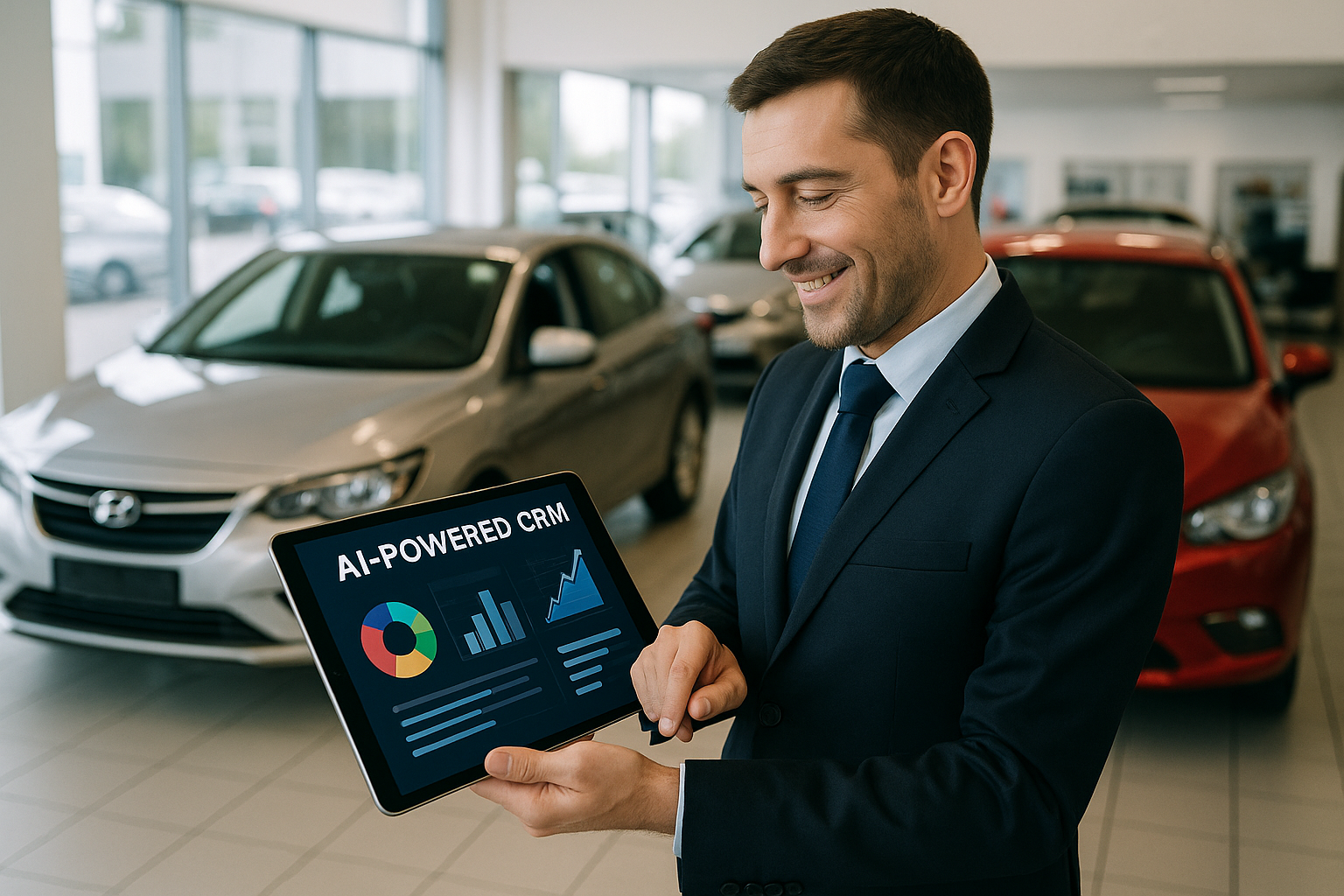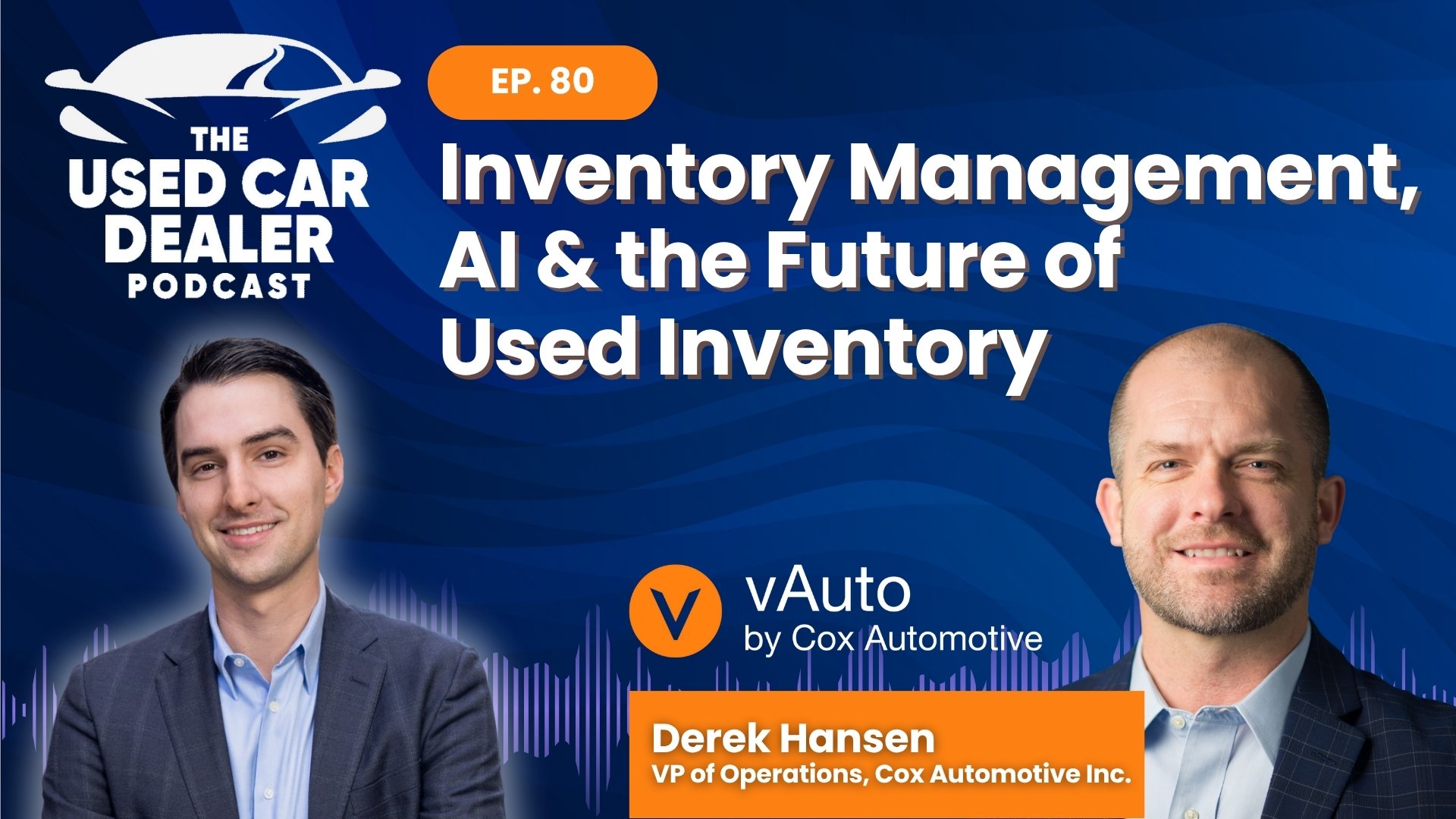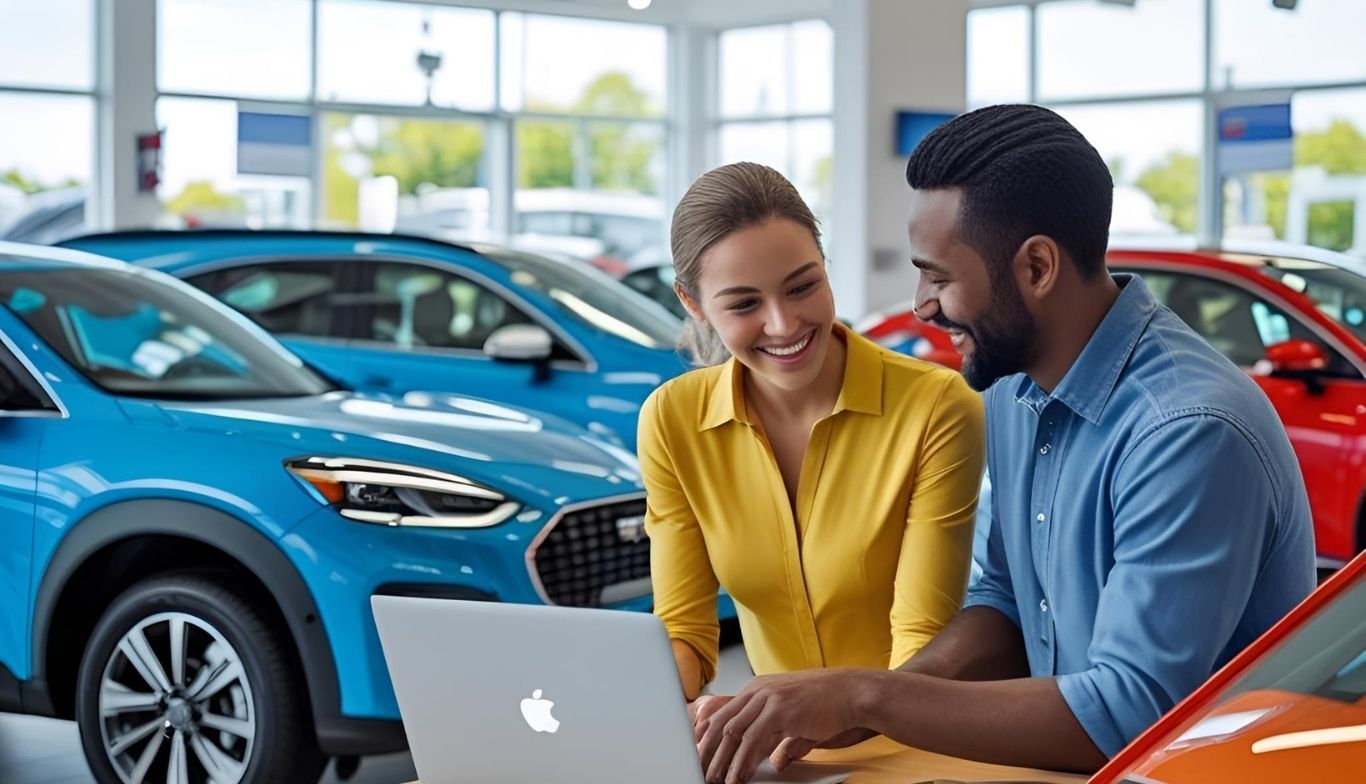In this episode transcript of the Used Car Dealer Podcast, Zach Klempf interviews Danny Zalasvsky of VinCue.
Zach Klempf: All right, well, Zach here and we have a great guest on the podcast today, Danny Zaslavsky from VinCue. Thanks so much for joining me on the podcast today. And for the audience listening today, talk about your background in the automotive space and how you got involved in the VinCue business.
Danny Zaslavsky: So I've been in the car business since I was a kid, my dad started it in 1983, we've always been a used car, automotive dealer. And I joined when I was about 14 years old, to prove to my dad that I could sell cars, but then quickly figured out that I really liked where industry and technology kind of met. And at the time, that was really in marketing, because you got to work with other technology companies in order to broadcast your message. And so I didn't know back then that I would one day be in technology, but I was certainly attracted to it. And we grew our business, organically over time, something that was unique to us. We decided early on that we didn't want a floor plan, meaning we weren't gonna borrow money to build our business. And so that forced us to make decisions differently in the way that we grew and the way that we grew our inventory, because we wanted to own everything for cash and, and not be beholden to making decisions based on fear. But instead, let's make them based on what our business actually needs. So as that idea continues to evolve through our company, that also started changing the way that we price cars. And that's some of the conversations that we have, which introduced me to Matt Watson, back in the day, my dad bought our first computer from Matt at Sears and asked Matt , ”Hey, do you know how to work this thing?” And he said, “Sure.” My dad said you should come out and set this thing up. So Matt came into our dealership, set it up and we asked him,`Hey, do you know how to build any programs?” Because we want to build a program to sell cars from and he goes, “Sure I'll build that.” So Matt built our first point of sale system called Sell Some Cars. We quickly figured out that we had a syndication issue because it didn't exist back there back then. And so he built VinStickers, which one day grew into VinSolutions. And Mats continues to be a friend of ours, so because of that, you know, let's fast forward to my early 30s. I wanted to get into the software space and Matt being my friend, I said, “Hey, I want to start a software company because I see this, what I call race to the bottom on price. What should I do?” And he said, “Well, you know what, I know somebody who's in that space, and can write code, and already has the beginnings of something really great. You guys should meet. And then that's when I met Chris Hoke who today is my business partner at VinCue.
Zach Klempf: What a great story and we know Matt as well and a former guest of the podcast too. So 2020 and 2021, they've been surreal from an inventory standpoint. 2020 and 2021 have been surreal from an inventory standpoint, what has the inventory crisis taught us about market pricing?
Danny Zaslavsky: So I have a CarMax right across the street from me and they've been around, obviously, for a really long time and for over a decade, dealers, let them buy cars from the public quietly, like we didn't compete against them, right. There may be a few dealers around the country that figured it out and started doing private party acquisition, but CarMax predominantly was doing it for a really long time. And you know, the last guy with his hand up also paid the most. We tried to be innovative early on, and we passed out Nextel phones to new car dealerships, so that when they were trading for a car, they could ping us and say, “Hey, what's this thing worth,” and then we bid on it over the phone. And then we come in and buy it all. We called it war, wholesale, auction retail. So we buy it all and we distribute it to the market. And that was our innovative way back in the day still carrying black books in our pockets to buy cars. Well, that idea of you making your profit when you buy the car and not when you sell the car was really what fueled us into thinking, “Okay, how can we scale a vehicle buying center? And so how has COVID changed our outlook?” Well, first of all, for seven years now my dealership has had a vehicle buying center. So I have a manager and for agents that are solely focused on acquisition. Early on, it was not just private party but it was also auction because you know, we thought if we use data to our advantage, we can know where the honey holes are and buy a good car. But then we figured out when we started tracking, gross and turn that working with consumers the same way we sell cars, but to buy cars was really powerful. So when COVID hit early on, obviously, for everybody, it dried up, we, you know, nobody knew what the heck was happening if sales would be strong or weak or what. But once sales started picking up and automotive started facing an inventory shortage, we looked around and went, ,”Well, we don't have an inventory shortage, we have quite the opposite.” We were still wholesaling, even some cars. So the answer is, it really focused us on not just selling and marketing channels, but now acquisition channels. And I think it's doing that to the industry today.
Zach Klempf: What are the three things that good inventory management should be?
Danny Zaslavsky: So I call it the highest authentic value. That's a term that VinCue uses, highest authentic value. Today is different than it was even a couple of years ago. So if we think about a piece of merchandise, a car, when you put it out there in the world, year, make, model, mileage, and condition history. That's really all that can rank a vehicle online in syndicates use like, fair deal, good deal, great deal, right. But there's a limited number of factors that can put that superlative on that vehicle. What's more important is for the dealer to communicate the highest authentic value. And some of those values are above and beyond price, right. So values like this vehicle got $1,200 worth of service done to it. It's got new tires, belts, brakes, hoses, this vehicle is also certified, gives it a year warranty. This vehicle also has a one owner clean Carfax, no accidents that's got value relative to other cars like it. This vehicle also was a local trade and we know the local market, and it didn't come from a high salt area, all those have value to a consumer. You know, just speaking for me I think you'd probably be the same, you pay a little bit more money for that car, if you were given that information, right. So in an inventory management system, like VinCue , highest authentic value is really important. Certainly, you still have the foundation of knowledge to understand your competitive set. What other vehicles are selling for whether it be retail transaction data, or similar, or wholesale transaction data. But even in the wholesale space, you know, you're competing with other experts. So those numbers can drive you again, back to that idea of race to the bottom. So it's important that you have not just wholesale data to look at, but what are they leaving the market for? And is your comp set even accurate? Are you competing with dealers who are inaccurately merchandising their cars? So again, dealers need to communicate the highest authentic value in their car, they need a system to be able to do that, because that increases growth that increases churn that makes a dealership more successful.
Zach Klempf: So oftentimes dealers they're conditioned to drop prices, for instance, if a car isn't moving, is that the right strategy?
Danny Zaslavsky: It's not, it's a strategy, but it's not the strategy. So let's paint the perfect picture. If you have a car, and you've merchandised it to its highest authentic value, the pictures are right, the comments are right, you've listed reconditioning. You've, given a consumer call to action, a way to reach you, and you're doing a good job, but the for some reason, the car still not moving, let's say it's a Ford Fusion or Chevy Impala that traditionally has a high market day supply as a lot of them out there. Right? The answer isn't to just lower the price hoping and praying that you're going to get somebody's attention. The answer is to boost the vehicle so that you can get out in front of other eyeballs. And so we call that VIN specific targeted advertising. So in today's world, we can see the behavior of other consumers in a market. And we can see what they're shopping for by class, by price range, what sites they're on and so forth. So if we can serve that vehicle that we have to have a consumer, then we can get that consumer back to us and sell that vehicle. Even at a great fair price. Right? But if the vehicle has $2,000 less than every other car. The only other way, the only way we're going to grab that consumer is if that consumer is already educated on the other vehicles and has boiled down that ours is the cheapest one. So I would call that a really bad strategy. In today's world specifically within VinCue, you don't have to do that. So increase growth and increase churn. So that we can commoditize. Some of the commoditization that's happened with a velocity mentality.
Zach Klempf: And obviously, inventory management is a key component of a successful used car dealer operation. What else is important for us car dealers to get right in this marketplace?
Danny Zaslavsky: So today, the loyalty has shifted from a good business, to a good experience. So Zach, think about it for yourself, if your parents and your grandparents have always done business with this one dealership, but you go in there, and today, it wasn't a good experience, you're not going to have loyalty to that business anymore. And so what specifically people our age, are looking for is a great experience. And so getting creative around how we can remove friction from a vehicle acquisition or vehicle selling experience. Dealers ultimately giving consumers the ability to communicate in a multi communication way. I'll give you an example. For years, we were like, hey, texting is a big deal, you should text your consumers. And so we told all of our salespeople to text text, text texts, and so they listened, they started texting. Well, we put some people off, and I'll tell you why. It's because some people hated texting. And so what we learned was ask, Zach, how do you want to be communicated with? Do you prefer text? Or do you prefer, I'll call you or do you want an email? And they'll say, No, you know, what, just call me it's a lot faster for me. And we'll go cool. And then we take in the notes, this customer likes to be called. And so a guy, like, my dad hates texting, because hes not good at the thumbs and all that stuff, right? Versus other people say, No, no, no, I'm at work all day, you need to text me. Cool. So the answer is: ask. And you can kind of take that intention and spread it across your business, so that you can give good experiences to the customer. And then at the end of it, I feel dealerships deserve a compliment, or a testimonial or two in and that goes beyond just a review on Google. We do exit interviews with our customers where we literally have a questionnaire and we ask them if they'd be willing to do a video testimonial. And so we'll do a little video with them in this little office, and we say hey, how's your experience? And we'll ask them leading questions like, do you feel like you got a good deal? Right? Because that's what other people are thinking, right? Yeah. We ask them questions, like, , Did you get what you want it? And they'll answer that question. It's authentic, and it's real. And you get to see real people. And it's not us going out there and saying, we're the best, you should shop with us. It's other people saying, You know what? This place is kind of cool.
Zach Klempf: So what are some of the most successful dealers doing differently when it comes to marketing their dealership and inventory?
Danny Zaslavsky: So you said something, you used the word differently. And I like that, because one of my tenants is sometimes better is better than better, sometimes different, is better than better. And in a climate where differentiating yourself is important, I truly believe different is better than better. Now, you've heard the old saying, don't be different for the sake of different so just be authentically different. And so for us, I'll give you an example of that. We used to specialize in a $3,000 to $12,000 price range. That's a really hard price range to specialize in right in the 90s. In the 80s. We were selling a ton of cars for five and six and seven grand good cars. We had an inventory of 200 cars that were serviced local. New Car trades in a $6,000 and $7,000 price range. Where are you going to find that amount of inventory, that is service with a bow on it right? Today, we specialize in that $5,000 to $15,000 price range. Now I still have a lot of cars in $20,000 and $30,000 price range, we have that. But if you're looking for the place to go to buy a $12 or $14,000 car with 60,000 miles that is service certified, you'll have a good experience and you'll get where you want to get a good deal. We're the place to go. So that's different enough. And that differentiates us from the big stores. And keep in mind I'm an independent right. I don't have a flag to fly. I don't have a truck showing up every week with inventory. I'm not taking trades on new cars to put on my watch. So we've got to be gritty and inventive to continue to be relevant.
Zach Klempf: So what advice do you have for used car dealer, they're just getting into business, maybe they just got their dealer's license, and they're starting to build their initial inventory management strategy?
Danny Zaslavsky: So my advice to you is, the car business is no longer a brick and mortar business, it is a technology business. So you got to think about it from the aspect of he or she who has the inventory has the opportunity, and inventory, because we're in an inventory based opportunity industry, that inventory has a commodity value, and then has a consumer value. And so if you focus on that consumer value, and you build a good experience, can you commit to a quality, frictionless digital and in person experience, then the rest of it will figure itself out. And what I mean by that is like, look at your business through those filters. And then you can answer questions every time you come up on whether you should do this or that, does it align with a frictionless digital experience that gives highest authentic value to the consumer? Yes or no? Yes, we do that.
Zach Klempf: So why is it hard from both a technologist and a dealer standpoint to build inventory management software?
Danny Zaslavsky: There's been a lot of legacy conversations going on. My dad for years, walked around with a Blackbook in his pocket, right, at some point that shifted, people didn't use paper, Blackbooks, right? Because there was other information and other insights to make good decisions from and then it shifted to a system that gave you what I call tunnel vision to see certain other insights, whether it be it be MMR, whether it be Blackbooks in there, right. Now I have these things to make a decision on an appraisal and we're kind of at this unique spot right now. Because of the system the legacy systems that are in place, again, have kind of reached this tipping point of tunnel vision, where no longer does Mannheim transaction data give you enough information, to appraise a car and actually still make money. That's that's really the end. And so simply adjusting a percent to market or cost to market isn't a way to succeed at scale, you're going to be making three and $600 grosses on the front. And you got to sell a whole lot of cars and run really, really fast, in order to make any profit under that kind of system. So inventory management today and market pricing today, in some ways, has had to be creative in the data that it uses to provide insights to dealers so that they can get the lens of the customer, not the lens of other dealers. Does that make sense? The insights that we as the audience have been looking at have been the lens of the other dealers, wholesale numbers, transaction numbers, blah, blah, blah. Forget that for a minute. Let's see, let's put ourselves in the customer seat, especially with the changing landscape today. And let's get insights so that we can get the lens of the consumer. And, again, go back to that create a good experience for them.
Zach Klempf: So lastly, Danny, what's coming down the pipeline for VinCue?
Danny Zaslavsky: Yeah. So we pride ourselves on being bleeding edge and innovative and behind me, above me, and in front of me, are a team of really amazing innovators. So we are very excited about what we call Boost, which is our event specific targeted advertising. We feel it's going to be revolutionary in the way that dealers can get more eyeballs on vehicles individually instead of just grouping it by SUVs or sedans or minivans. But we know we have the insights to say, hey, from the moment I bought this car, it has the propensity to be online for 60 days, but I don't want to lower my price. In order to sell it faster. How about I put the highest authentic value on it, and put it in front of consumers who are actually looking for it. So I can sell it in 14 days or 20 days and maintain that gross and turn in have the same muscle to compete as the big dealer groups and even some of the online retailers. That is what we're focused on so that dealers can stay strong and stay in the game and be relevant.
Zach Klempf: Awesome. I mean, Danny, I've really enjoyed this podcast, what you've built is super impressive and the fact that you're running without a floor plan in 2021 is probably shocking to a lot of dealers listening to this episode, but very impressive.
Danny Zaslavsky: Exactly. You asked some pretty good questions, man.
Zach Klempf: Awesome. Well, thanks for joining.






.jpg)
.jpg)
.jpg)
.jpg)


.jpg)
.png)
.png)
